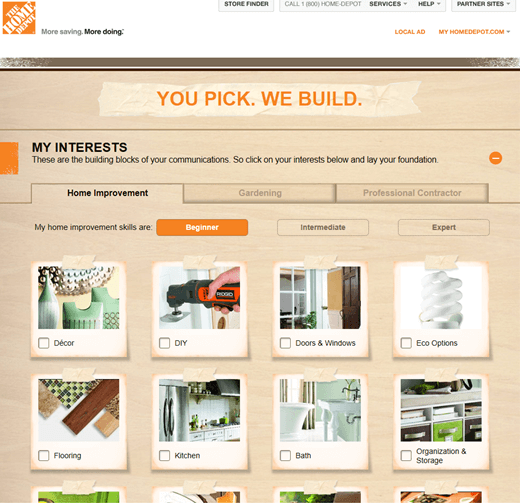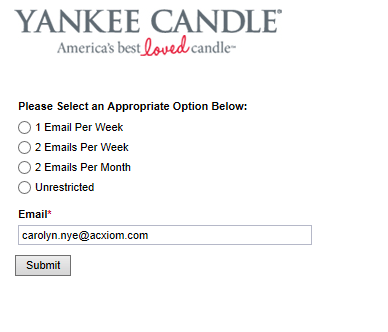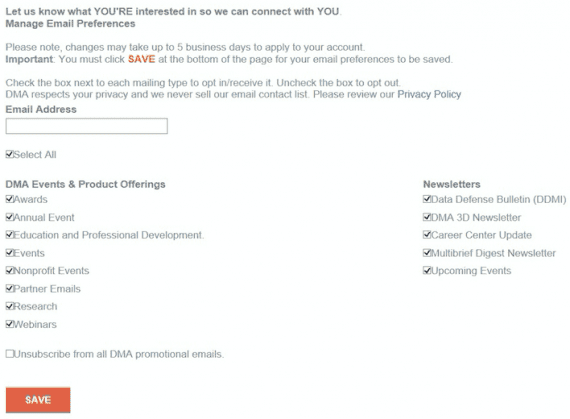
Email preference centers can allow subscribers to choose the frequency in which they receive emails, as well of the types of content they want to receive. Home Depot’s preference center, for example, allows users to choose their skill level and interests in an easy-to-navigate process.
Years ago, email preference centers popped up on all kinds of websites. Preference centers were an effort to curb email unsubscribes and to protect a core digital asset: the email database. In this article, I’ll explore what email preference centers are and the pros and cons of using them.
A preference center is simply a page or section of your website where subscribers choose what types of email content they receive from you, and the frequency at which they receive it.
There are different types of preference centers based on the type of site or business. Some will simply ask subscribers how often they want o receive emails, such as daily, weekly, or monthly. Some will allow subscribers to choose what type of content or information they will receive ? such as newsletters, promotional offers, or other types of communications.
Many ecommerce sites have created email preference centers. To get to these sections of a site, subscribers typically locate a link near an unsubscribe button on the bottom of an email. For example, Yankee Candle includes a link in all emails, above the “unsubscribe” link, that reads, “Click here to change your email frequency.”
Once clicked, this page is displayed.

Yankee Candle’s preference center simply allows subscribers to change the frequency in which they receive the emails.
Yankee Candle allows subscribers to choose how often they want to receive emails. In this simplistic form, a preference center?s main objective is to keep people subscribed by allowing them to reduce the frequency.
More detailed preference centers may ask subscribers about the types of content they want to receive. Below is an example of the Direct Marketing Association’s preference center, which allows subscribers to opt in to certain types of messages and opt out of others.

Direct Marketing Association’s preference center allows subscribers to opt in to certain types of messages and opt out of others.
Pros and Cons of Email Preference Centers
Some email marketers argue that preference centers are no longer needed because only a small fraction of subscribers use them. Moreover, what a subscriber actually does is often vastly different than what he indicates on a questionnaire or survey.
Proponents of preference centers argue that they offer an alternative to unsubscribing, and that they address what subscribers often feel: Many emails are no longer relevant. In addition, a preference center allows subscribers to tailor content, for a more personalized experience.
Oftentimes, in my experience, the decision to launch a preference center or to nix an already-existing one boils down to the time and cost of implementation and maintenance, not the benefit to subscribers. The main objectives for a preference center typically include:
- Reducing the unsubscribe rate;
- Providing more relevant communications, which will increase open, clicks, and conversions;
- Providing quality service to customers.
A relatively small cost to implement and maintain a preference center may make sense for your company, depending on your goals. Take, for example, the goal of reducing unsubscribes. Say you are able to prevent 30 percent of those who want to unsubscribe from doing so, and your current unsubscribe rate is 1 percent per year on a file size of 500,000 subscribers.
At the end of a year you may have saved about 1,500 recipients from unsubscribing. However, if the cost to set up and maintain the preference center exceeds the potential benefit of marketing to those 1,500 subscribers, then having one may not be the answer.
Many email service providers offer relatively easy-to implement preference centers as part of their software. Thus your cost may be minimal or even free.
Case Study: Home Depot
One of the best uses of preference centers is to better understand the type of products and?services that subscribers are interested in. To capture these elements successfully, consider asking this information during the opt-in process via an intuitive, streamlined flow. One of the best examples of this is Home Depot.
Home Depot caters to contractor professionals as well as novice, do-it-yourself consumers. Thus Home Depot allows users to first choose whether they are a homeowner or contractor. From there, through a nicely designed multi-tab process, users can choose their skill level and various areas of interest in an easy-to-navigate and image-friendly process.
From the information it collects via the opt-in process, Home Depot can presumably tailor content and products for its customers. Having more relevant email communications will likely keep unsubscribes lower and engagement higher. In other words, Home Depot’s preference center likely improves sales.
